Non-Hodgkin Lymphoma Treatment
Find comprehensive, compassionate care for pediatric non-Hodgkin lymphoma—a type of cancer that affects the lymph system (part of the body’s immune system)—at the Montefiore Einstein Comprehensive Cancer Center at the Children’s Hospital at Montefiore Einstein (CHAM). CHAM is a premier academic children’s hospital nationally renowned for its clinical excellence and innovative research. Families from throughout the New York metropolitan area, across the country and around the globe trust us to provide the most advanced cancer therapies for their children in a supportive and nurturing environment.
We offer the full range of treatments for non-Hodgkin lymphoma, including options such as CAR T-cell therapy and stem cell transplants, for hard-to-treat cancers and cancers that recur. In an effort to provide the best possible care, we have assembled a team of outstanding physicians, specialists and support staff, including some of the nation’s most formidable experts in pediatric bone marrow transplantation (BMT). Our BMT program is certified by the Foundation for the Accreditation of Cellular Therapy and the National Marrow Donor Program. In addition, CHAM is an active member of the Pediatric Blood and Marrow Transplantation Consortium, the Children’s Oncology Group and the Center of International Blood and Marrow Transplantation Research.
Our research efforts are designed to test promising new therapies and clinical trials offer the most advanced, up-to-date treatments options.
When you want only the best for your child, turn to the caring specialists at Montefiore Einstein Comprehensive Cancer Center at CHAM, who are passionate about ending cancer and addressing your child’s whole health needs.

Cancer Clinical Trials
- Blood & Bone Marrow Cancers
- Brain, Spine & Central Nervous System Cancers
- Breast Cancer
- Childhood Cancers
- Endocrine System Cancers
- Gastrointestinal (GI) Cancers
- Genitourinary (GU) & Urologic Cancers
- Gynecologic Cancers
- Head & Neck Cancers
- Kaposi Sarcoma & AIDS-Related Cancers
- Lung & Chest Cancers
- Prostate Cancer
- Sarcomas
- Skin Cancer
As an NCI-designated comprehensive cancer center, Montefiore Einstein Comprehensive Cancer Center supports the mission and guidelines of the National Cancer Institute (NCI). The following information about types of cancer, prevention and treatments is provided by the NCI.
Childhood Non-Hodgkin Lymphoma Treatment (PDQ®)–Patient Version
General Information About Childhood Non-Hodgkin Lymphoma
Key Points
- Childhood non-Hodgkin lymphoma is a cancer that forms in the lymph system, which is a part of the body's immune system.
- There are three major types of childhood non-Hodgkin lymphoma.
- Aggressive mature B-cell non-Hodgkin lymphoma
- Lymphoblastic lymphoma
- Anaplastic large cell lymphoma
- Some types of non-Hodgkin lymphoma are rare in children.
- Having a weakened immune system increases the risk of NHL in children.
- Symptoms of childhood non-Hodgkin lymphoma include breathing problems and swollen lymph nodes.
- Tests that examine the body and lymph system are used to diagnose and stage childhood non-Hodgkin lymphoma.
- You may want to get a second opinion to confirm your child's cancer diagnosis.
- Certain factors affect prognosis (chance of recovery) and treatment options.
Childhood non-Hodgkin lymphoma is a cancer that forms in the lymph system, which is a part of the body's immune system.
The immune system helps protect the body from infection and disease.
The lymph system is made up of:
- Lymph: Colorless, watery fluid that travels through the lymph vessels and carries lymphocytes (white blood cells).
- B lymphocytes, also called B cells, make antibodies to help fight infection. Most types of non-Hodgkin lymphoma begin in B lymphocytes.
- T lymphocytes, also called T cells, help B lymphocytes make the antibodies that help fight infection.
- Natural killer cells, also called NK cells, attack cancer cells and viruses.
- Lymph vessels: A network of thin tubes that collect lymph from different parts of the body and return it to the bloodstream.
- Lymph nodes: Small, bean-shaped structures that filter lymph and store white blood cells that help fight infection and disease. Lymph nodes are found along a network of lymph vessels throughout the body. Groups of lymph nodes are found in the neck, underarm, mediastinum (the area between the lungs), abdomen, pelvis, and groin.
- Spleen: An organ that makes lymphocytes, stores red blood cells and lymphocytes, filters the blood, and destroys old blood cells. The spleen is on the left side of the abdomen near the stomach.
- Thymus: An organ in which T lymphocytes mature and multiply. The thymus is in the chest behind the breastbone.
- Tonsils: Two small masses of lymph tissue at the back of the throat. There is one tonsil on each side of the throat.
- Bone marrow: The soft, spongy tissue in the center of certain bones, such as the hip bone and breastbone. White blood cells, red blood cells, and platelets are made in the bone marrow.
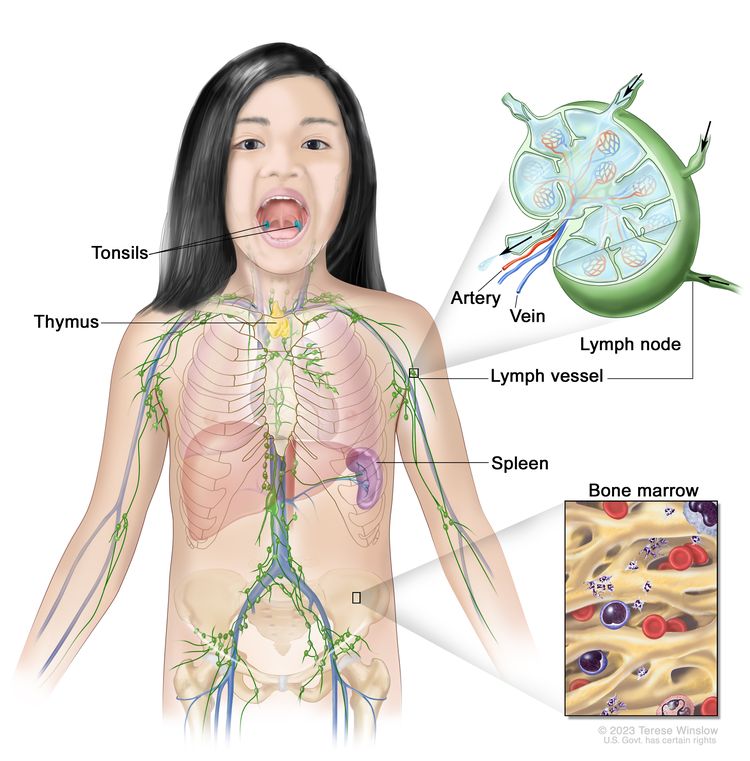
The lymph system is part of the body's immune system and is made up of tissues and organs that help protect the body from infection and disease. These include the tonsils, thymus, spleen, bone marrow, lymph vessels, and lymph nodes. Lymph (clear, watery fluid) and lymphocytes (white blood cells) travel through the lymph vessels and into the lymph nodes where the lymphocytes destroy harmful substances. The lymph enters the bloodstream through a large vein near the heart.
Lymph tissue is also found in other parts of the body such as the stomach, thyroid gland, brain, and skin.
Non-Hodgkin lymphoma can begin in B lymphocytes, T lymphocytes, or natural killer cells.
There are two general types of lymphomas: Hodgkin lymphoma and non-Hodgkin lymphoma. This summary is about the treatment of childhood non-Hodgkin lymphoma. Learn more about Childhood Hodgkin Lymphoma Treatment.
Treatment of non-Hodgkin lymphoma is different for children and adults. For information about treatment of adults, see:
There are three major types of childhood non-Hodgkin lymphoma.
The type of lymphoma is determined by how the cells look under a microscope. The three major types of childhood non-Hodgkin lymphoma are:
Aggressive mature B-cell non-Hodgkin lymphoma
Aggressive mature B-cell non-Hodgkin lymphomas include:
- Burkitt lymphoma: Burkitt lymphoma is an aggressive (fast-growing) cancer that develops from B lymphocytes and is most common in children, adolescents, and young adults. It may form in the abdomen, Waldeyer's ring, testicles, bone, bone marrow, skin, or central nervous system (CNS).
Burkitt lymphoma has been linked to infection with the Epstein-Barr virus (EBV). Burkitt lymphoma is more common in White people than in Hispanic people. Burkitt lymphoma is diagnosed when a sample of tissue is checked and a certain change to the MYC gene is found.
- Diffuse large B-cell lymphoma: Diffuse large B-cell lymphoma is the most common type of non-Hodgkin lymphoma. It is a type of B-cell non-Hodgkin lymphoma that grows quickly in the lymph nodes. The spleen, liver, bone marrow, or other organs are also often affected. Diffuse large B-cell lymphoma occurs more often in adolescents than in children.
- Primary mediastinal B-cell lymphoma: A type of lymphoma that develops from B cells in the mediastinum (the area between the lungs). It may spread to nearby organs including the lungs and the sac around the heart. It may also spread to lymph nodes and distant organs including the kidneys. Primary mediastinal B-cell lymphoma occurs more often in older adolescents than in children.
Lymphoblastic lymphoma
Lymphoblastic lymphoma is a type of lymphoma that mainly affects T-cell lymphocytes. It usually forms in the mediastinum (the area between the lungs). This causes trouble breathing, wheezing, trouble swallowing, or swelling of the head and neck. It may spread to lymph nodes, bone, bone marrow, skin, the CNS, abdominal organs, and other areas. Lymphoblastic lymphoma is a lot like acute lymphoblastic leukemia (ALL).
Anaplastic large cell lymphoma
Anaplastic large cell lymphoma is a type of lymphoma that mainly affects T-cell lymphocytes. It usually forms in the lymph nodes, skin, or bone, and sometimes forms in the gastrointestinal tract, lung, tissue that covers the lungs, and muscle. Patients with anaplastic large cell lymphoma have a receptor, called CD30, on the surface of their T cells. In many children, anaplastic large cell lymphoma is marked by changes in the ALK gene that makes a protein called anaplastic lymphoma kinase. A pathologist checks for these cell and gene changes to help diagnose anaplastic large cell lymphoma.
Some types of non-Hodgkin lymphoma are rare in children.
Some types of childhood non-Hodgkin lymphoma are less common. These include:
- Pediatric-type follicular lymphoma: In children, follicular lymphoma occurs most often in males. It is more likely to be found in one area and does not spread to other places in the body. It usually forms in the tonsils and lymph nodes in the neck, but may also form in the testicles, kidney, gastrointestinal tract, and parotid gland.
- Marginal zone lymphoma: Marginal zone lymphoma is a type of lymphoma that tends to grow and spread slowly and is usually found at an early stage. It may be found in the lymph nodes or in areas outside the lymph nodes. Marginal zone lymphoma found outside the lymph nodes in children is called mucosa-associated lymphoid tissue (MALT) lymphoma. MALT may be linked to Helicobacter pylori infection of the gastrointestinal tract and Chlamydophila psittaci infection of the conjunctival membrane which lines the eye. Marginal zone lymphoma is rare in children and adults.
- Primary central nervous system (CNS) lymphoma: Primary CNS lymphoma is extremely rare in children. Most primary CNS lymphoma is diffuse large B-cell lymphoma.
- Peripheral T-cell lymphoma: Peripheral T-cell lymphoma is an aggressive (fast-growing) non-Hodgkin lymphoma that begins in mature T lymphocytes. Other types of peripheral T-cell lymphoma include mature T-cell/natural killer-cell lymphoma, extranodal NK/T-cell lymphoma, and gamma-delta hepatosplenic T-cell lymphoma. Peripheral T-cell lymphoma is rare in children.
- Cutaneous T-cell lymphoma: Cutaneous T-cell lymphoma begins in the skin and can cause the skin to thicken or form a tumor. It is very rare in children but is more common in adolescents and young adults. There are different types of cutaneous T-cell lymphoma, such as cutaneous anaplastic large cell lymphoma, subcutaneous panniculitis-like T-cell lymphoma, gamma-delta T-cell lymphoma, mycosis fungoides, and lymphomatoid papulosis. Mycosis fungoides rarely occurs in children and adolescents.
Having a weakened immune system increases the risk of NHL in children.
A risk factor is anything that increases the chance of getting a disease. Not every child with one or more of these risk factors will develop NHL. And it will develop in some children who don't have a known risk factor.
Some immune system problems may increase the risk of childhood NHL. These immune system problems include:
- being infected with the Epstein-Barr virus or HIV
- having a weakened immune system after a transplant or from medicines given after a transplant
- having certain inherited diseases (such as DNA repair defect syndromes, which include ataxia-telangiectasia, Nijmegen breakage syndrome, and constitutional mismatch repair deficiency)
- past treatment for cancer
If lymphoma or lymphoproliferative disease is linked to a weakened immune system from certain inherited diseases, HIV infection, a transplant, or medicines given after a transplant, the condition is called lymphoproliferative disease associated with immunodeficiency. The different types of lymphoproliferative disease associated with immunodeficiency include:
- lymphoproliferative disease associated with primary immunodeficiency
- HIV-associated non-Hodgkin lymphoma
- post-transplant lymphoproliferative disease
- lymphoproliferative disease from chemotherapy
Talk with your child's doctor if you think your child may be at risk.
Symptoms of childhood non-Hodgkin lymphoma include breathing problems and swollen lymph nodes.
The symptoms of childhood non-Hodgkin lymphoma depend on the where the cancer forms in the body. It's important to check with your child's doctor if your child has:
- trouble breathing
- wheezing
- coughing
- high-pitched breathing sounds
- swelling of the head, neck, upper body, or arms
- trouble swallowing
- painless swelling of the lymph nodes in the neck, underarm, stomach, or groin
- painless lump or swelling in a testicle
- fever for no known reason
- weight loss for no known reason
- drenching night sweats
- pain or swelling in the abdomen
- weakness, numbness, or pain in the back or legs
- a change in bowel or bladder control
- bone or joint pain
- fatigue
These symptoms may be caused by problems other than non-Hodgkin lymphoma. The only way to know is to see your child's doctor.
Tests that examine the body and lymph system are used to diagnose and stage childhood non-Hodgkin lymphoma.
If your child has symptoms that suggest non-Hodgkin lymphoma, the doctor will need to find out if these are due to cancer or another problem. The doctor will ask when the symptoms started and how often your child has been having them. They will also ask about your child's personal and family health history and do a physical exam. Depending on these results, they may recommend other tests. If your child is diagnosed with non-Hodgkin lymphoma, the results of the tests will help plan treatment.
The tests used to diagnose and stage non-Hodgkin lymphoma may include:
- Blood chemistry studies use a blood sample to measure the amounts of certain substances released into the blood by organs and tissues in the body, including electrolytes, lactate dehydrogenase (LDH), uric acid, blood urea nitrogen (BUN), creatinine, and liver function values. An unusual amount of a substance can be a sign of disease.
- Liver function tests measure the amounts of certain substances released into the blood by the liver. A higher-than-normal amount of a substance can be a sign of cancer.
- CT scan (CAT scan) uses a computer linked to an x-ray machine to make a series of detailed pictures of areas inside the body, such as the neck, chest, abdomen, and pelvis. The pictures are taken from different angles and are used to create 3-D views of tissues and organs. A dye may be injected into a vein or swallowed to help the organs or tissues show up more clearly. This procedure is also called computed tomography, computerized tomography, or computerized axial tomography. Learn more about Computed Tomography (CT) Scans and Cancer.
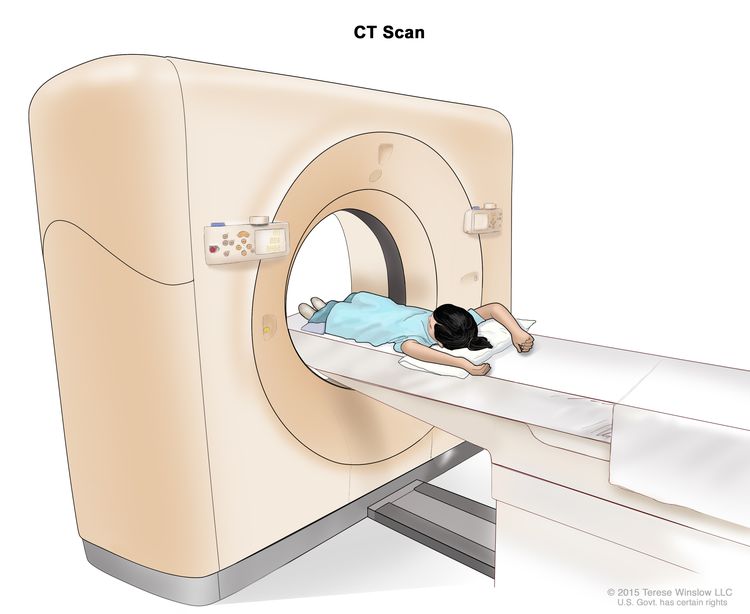
Computed tomography (CT) scan. The child lies on a table that slides through the CT scanner, which takes a series of detailed x-ray pictures of areas inside the body.
- PET scan (positron emission tomography scan) uses a small amount of radioactive sugar (also called radioactive glucose) that is injected into a vein. The PET scanner rotates around the body and makes pictures of areas inside the body where the sugar is being used by the body. Cancer cells show up brighter in the pictures because they are more active and take up more sugar than normal cells do. Sometimes a PET scan and a CT scan are done at the same time.
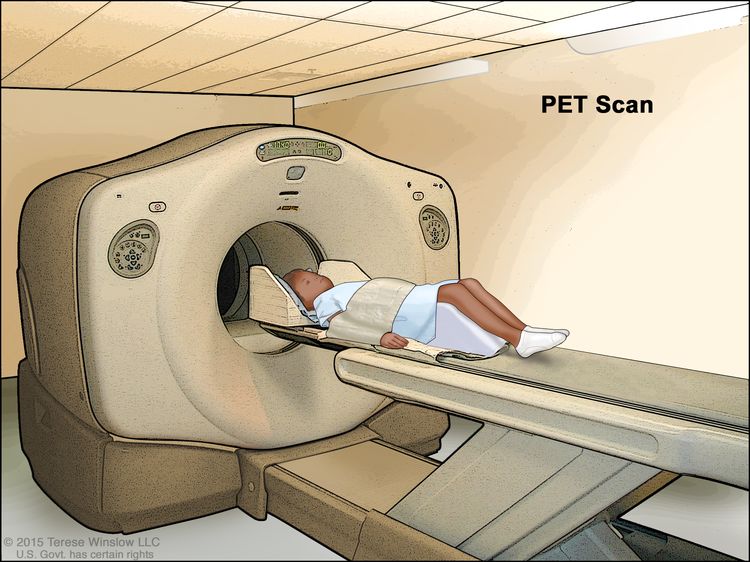
Positron emission tomography (PET) scan. The child lies on a table that slides through the PET scanner. The head rest and white strap help the child lie still. A small amount of radioactive glucose (sugar) is injected into the child's vein, and a scanner makes a picture of where the glucose is being used in the body. Cancer cells show up brighter in the picture because they take up more glucose than normal cells do.
- Magnetic resonance imaging (MRI) uses a magnet, radio waves, and a computer to make a series of detailed pictures of areas inside the body. This procedure is also called nuclear magnetic resonance imaging (NMRI).

Magnetic resonance imaging (MRI) scan. The child lies on a table that slides into the MRI machine, which takes a series of detailed pictures of areas inside the body. The positioning of the child on the table depends on the part of the body being imaged.
- Lumbar puncture is a procedure used to collect a sample of cerebrospinal fluid (CSF) from the spinal column. This is done by placing a needle between two bones in the spine and into the lining around the spinal cord to remove a sample of CSF. The sample of CSF is checked under a microscope for cancer.

Lumbar puncture. A patient lies in a curled position on a table. After a small area on the lower back is numbed, a spinal needle (a long, thin needle) is inserted into the lower part of the spinal column to remove cerebrospinal fluid (CSF, shown in blue). The fluid may be sent to a laboratory for testing.
- Chest x-ray is a type of radiation that can go through the body and make pictures of the organs and bones inside the chest.
- Ultrasound uses high-energy sound waves (ultrasound) that bounce off internal tissues or organs and make echoes. The echoes form a picture of body tissues called a sonogram.
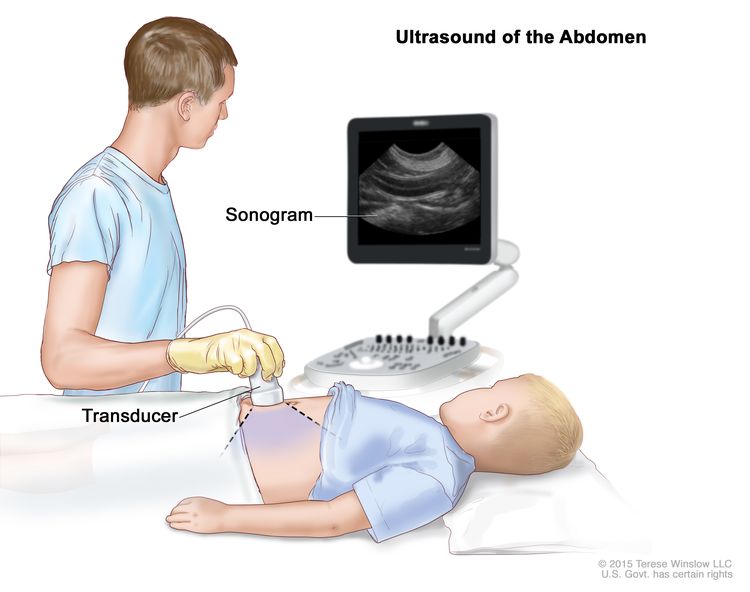
Abdominal ultrasound. An ultrasound transducer connected to a computer is pressed against the skin of the abdomen. The transducer bounces sound waves off internal organs and tissues to make echoes that form a sonogram (computer picture).
- Biopsy is the removal of a sample of cells or tissue from the tumor so that pathologist can view it under a microscope to check for cancer.
One of the following types of biopsies may be done:
The procedure used to remove the sample of tissue depends on where the tumor is in the body:
- Bone marrow aspiration and biopsy removes bone marrow and a piece of bone by inserting a hollow needle into the hip bone or breastbone. A pathologist views the bone marrow and bone under a microscope to look for cancer.
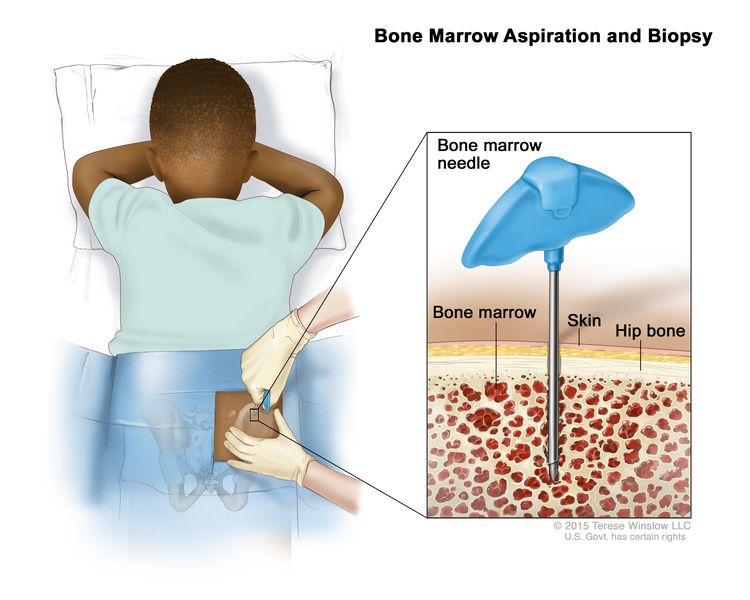
Bone marrow aspiration and biopsy. After a small area of skin is numbed, a bone marrow needle is inserted into the child’s hip bone. Samples of blood, bone, and bone marrow are removed for examination under a microscope.
- Mediastinoscopy is a surgical procedure to look at the organs, tissues, and lymph nodes between the lungs for abnormal areas. A cut (incision) is made at the top of the breastbone and a mediastinoscope is inserted into the chest. A mediastinoscope is a thin, tube-like instrument with a light and a lens for viewing. It also has a tool to remove tissue or lymph node samples, which are checked under a microscope for cancer.
- Anterior mediastinotomy is a surgical procedure to look at the organs and tissues between the lungs and between the breastbone and heart for abnormal areas. A cut (incision) is made next to the breastbone and a mediastinoscope is inserted into the chest. A mediastinoscope is a thin, tube-like instrument with a light and a lens for viewing. It also has a tool to remove tissue or lymph node samples, which are checked under a microscope for cancer. This is also called the Chamberlain procedure.
- Thoracentesis is the removal of fluid from the space between the lining of the chest and the lung, using a needle. A pathologist views the fluid under a microscope to look for cancer cells.
If cancer is found, the following tests may be done to study the cancer cells:
- Immunohistochemistry uses antibodies to check for certain antigens (markers) in a sample of a patient's cells or tissue. The antibodies are usually linked to an enzyme or a fluorescent dye. After the antibodies bind to a specific antigen in the tissue sample, the enzyme or dye is activated, and the antigen can then be seen under a microscope. This type of test is used to help diagnose cancer and to help tell one type of cancer from another type.
- Flow cytometry measures the number of cells in a sample, the percentage of live cells in a sample, and certain characteristics of the cells, such as size, shape, and the presence of tumor (or other) markers on the cell surface. The cells from a sample of a patient's blood, bone marrow, or other tissue are stained with a fluorescent dye, placed in a fluid, and then passed one at a time through a beam of light. The test results are based on how the cells that were stained with the fluorescent dye react to the beam of light. This test is used to help diagnose and manage certain types of cancers, such as leukemia and lymphoma.
- Cytogenetic analysis checks the chromosomes of cells in a sample of bone marrow, blood, tumor, or other tissue for broken, missing, rearranged, or extra chromosomes. Changes in certain chromosomes may be a sign of cancer. Cytogenetic analysis is used to help diagnose cancer, plan treatment, or find out how well treatment is working.
- FISH (fluorescence in situ hybridization) looks at and counts genes or chromosomes in cells and tissues. Pieces of DNA that contain fluorescent dyes are made in the laboratory and added to a sample of a patient's cells or tissues. When these dyed pieces of DNA attach to certain genes or areas of chromosomes in the sample, they light up when viewed under a fluorescent microscope. The FISH test is used to help diagnose cancer and help plan treatment.
- Immunophenotyping uses antibodies to identify cancer cells based on the types of antigens or markers on the surface of the cells. This test is used to help diagnose specific types of lymphoma.
You may want to get a second opinion to confirm your child's cancer diagnosis.
You may want to get a second opinion to confirm your child's diagnosis and treatment plan. If you seek a second opinion, you will need to get medical test results and reports from the first doctor to share with the second doctor. The second doctor will review the pathology report, slides, and scans. This doctor may agree with the first doctor, suggest changes to the treatment plan, or provide more information about your child's cancer.
To learn more about choosing a doctor and getting a second opinion, visit Finding Cancer Care. You can contact NCI's Cancer Information Service via chat, email, or phone (both in English and Spanish) for help finding a doctor or hospital that can provide a second opinion. For questions you might want to ask at your child's appointments, visit Questions to Ask Your Doctor About Cancer.
Certain factors affect prognosis (chance of recovery) and treatment options.
If your child has been diagnosed with non-Hodgkin lymphoma, you likely have questions about how serious the cancer is and your child's chances of survival. The likely outcome or course of a disease is called prognosis.
The prognosis depends on:
- the type of lymphoma
- where the cancer is in the body at diagnosis
- the stage of the cancer
- whether there are certain changes in the chromosomes
- the type of initial treatment
- whether the lymphoma responded to initial treatment
- your child's age and general health
No two people are alike, and responses to treatment can vary greatly. Your child's cancer care team is in the best position to talk with you about your child's prognosis.
Stages of Childhood Non-Hodgkin Lymphoma
Key Points
- After childhood non-Hodgkin lymphoma has been diagnosed, tests are done to find out if cancer cells have spread within the lymph system or to other parts of the body.
- The following stages are used for childhood non-Hodgkin lymphoma:
- Stage I
- Stage II
- Stage III
- Stage IV
- Sometimes childhood non-Hodgkin lymphoma does not respond to treatment or recurs (comes back) after treatment.
After childhood non-Hodgkin lymphoma has been diagnosed, tests are done to find out if cancer cells have spread within the lymph system or to other parts of the body.
Cancer stage describes the extent of cancer in the body, such as the size of the tumor, whether it has spread, and how far it has spread from where it first formed. It's important to know the stage of non-Hodgkin lymphoma to plan the best treatment.
For a description of the tests and procedures used to diagnose non-Hodgkin lymphoma, see General Information.
The following stages are used for childhood non-Hodgkin lymphoma:
Stage I
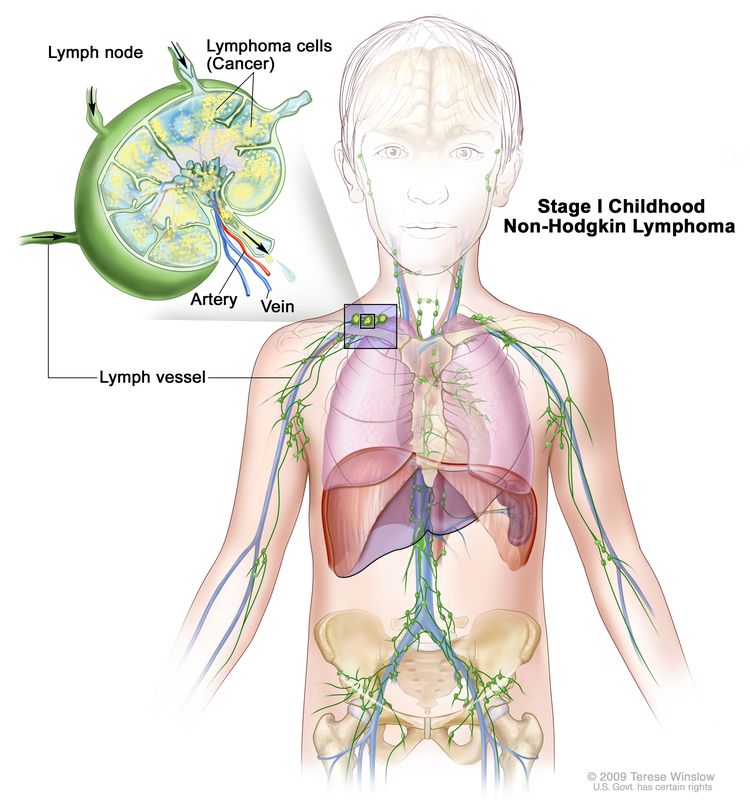
Stage I childhood non-Hodgkin lymphoma. Cancer is found in one group of lymph nodes or one area outside the lymph nodes, but no cancer is found in the abdomen or mediastinum (area between the lungs).
In stage I childhood non-Hodgkin lymphoma, cancer is found:
- in one group of lymph nodes; or
- in one area outside the lymph nodes.
No cancer is found in the abdomen or mediastinum (area between the lungs).
Stage II
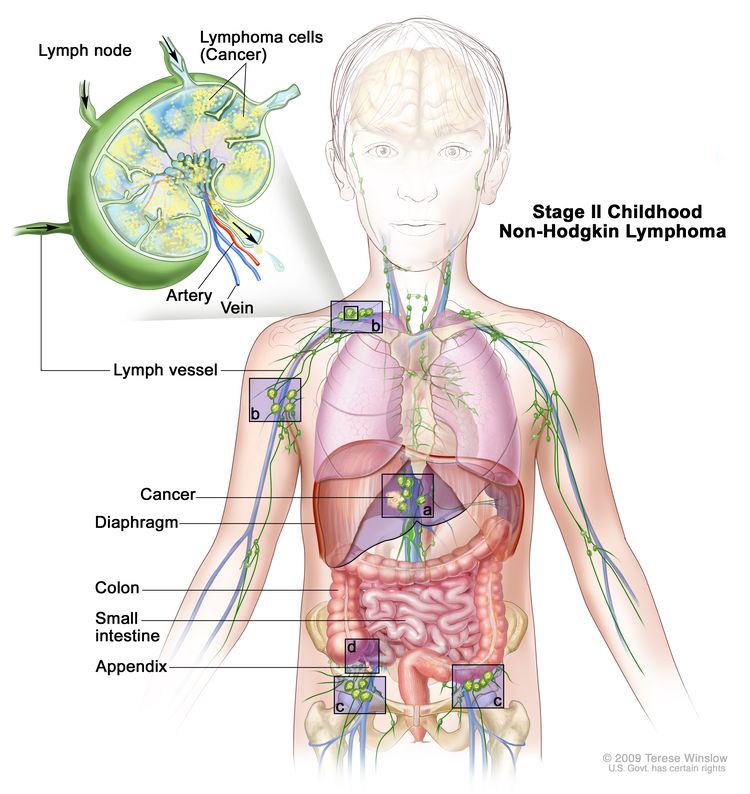
Stage II childhood non-Hodgkin lymphoma. Cancer is found in one area outside the lymph nodes and in nearby lymph nodes (a); or in two or more areas above (b) or below (c) the diaphragm; or cancer started in the stomach, appendix, or intestines (d) and can be removed by surgery.
In stage II childhood non-Hodgkin lymphoma, cancer is found:
- in one area outside the lymph nodes and in nearby lymph nodes; or
- in two or more areas either above or below the diaphragm, and may have spread to nearby lymph nodes; or
- to have started in the stomach or intestines and can be completely removed by surgery. Cancer may have spread to certain nearby lymph nodes.
Stage III
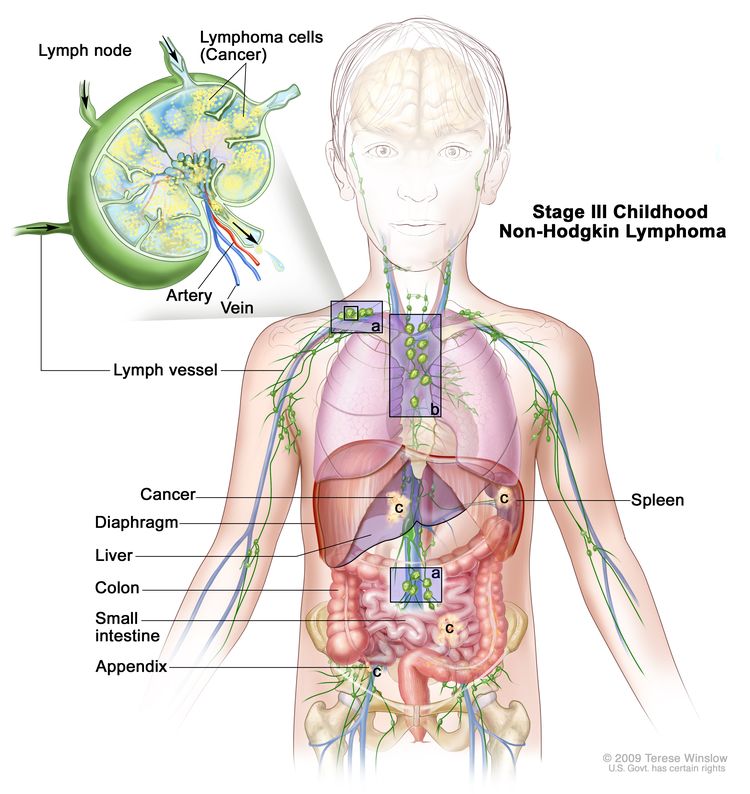
Stage III childhood non-Hodgkin lymphoma. Cancer is found in at least one area above and below the diaphragm (a); or cancer started in the chest (b); or cancer started in the abdomen and spread throughout the abdomen (c); or in the area around the spine (not shown).
In stage III childhood non-Hodgkin lymphoma, cancer is found:
Stage IV

Stage IV childhood non-Hodgkin lymphoma. Cancer is found in the bone marrow, brain, or cerebrospinal fluid (CSF). Cancer may also be found in other parts of the body.
In stage IV childhood non-Hodgkin lymphoma, cancer is found in the bone marrow, brain, or cerebrospinal fluid. Cancer may also be found in other parts of the body.
Sometimes childhood non-Hodgkin lymphoma does not respond to treatment or recurs (comes back) after treatment.
Refractory non-Hodgkin lymphoma is cancer that does not respond to initial treatment.
Recurrent non-Hodgkin lymphoma is cancer that has come back after treatment. It may come back in the lymph system or in other parts of the body.
Treatment Option Overview
Key Points
- There are different types of treatment for children with non-Hodgkin lymphoma.
- Children with non-Hodgkin lymphoma should have their treatment planned by a team of doctors who are experts in treating childhood cancer.
- The following types of treatment may be used:
- Surgery
- Chemotherapy
- Radiation therapy
- Stem cell transplant
- Targeted therapy
- Other drug therapy
- Phototherapy
- Watchful waiting
- Immunotherapy
- Treatment for childhood non-Hodgkin lymphoma may cause side effects.
- Patients may want to think about taking part in a clinical trial.
- Follow-up care may be needed.
There are different types of treatment for children with non-Hodgkin lymphoma.
You and your child's care team will work together to decide treatment. Many factors will be considered, such as where the cancer is located, the type of non-Hodgkin lymphoma, whether the cancer is newly diagnosed or has come back, and your child's age and overall health.
Your child's treatment plan will include information about the tumor, the goals of treatment, treatment options, and possible side effects. It will be helpful for you to talk with your child's care team before treatment begins about what to expect. For help every step of the way, visit our booklet, Children with Cancer: A Guide for Parents.
Children with non-Hodgkin lymphoma should have their treatment planned by a team of doctors who are experts in treating childhood cancer.
A pediatric oncologist, a doctor who specializes in treating children with cancer, oversees treatment of non-Hodgkin lymphoma. The pediatric oncologist works with other health care providers who are experts in treating children with cancer and also specialize in certain areas of medicine. Other specialists may include:
The following types of treatment may be used:
Surgery
Surgery may be done to remove as much of the tumor as possible for some types of childhood non-Hodgkin lymphoma. After the doctor removes all the cancer that can be seen at the time of surgery, patients may be given chemotherapy to kill any cancer cells that are left. Treatment given after the surgery, to lower the risk that the cancer will come back, is called adjuvant therapy.
Chemotherapy
Chemotherapy (also called chemo) uses drugs to stop the growth of cancer cells. Chemotherapy either kills the cells or stops them from dividing. Chemotherapy may be given alone or with other types of treatment.
Chemotherapy for childhood non-Hodgkin lymphoma is taken by mouth or injected into a vein. When given this way, the drugs enter the bloodstream and can reach cancer cells throughout the body. Chemotherapy for childhood non-Hodgkin lymphoma is also placed directly into the cerebrospinal fluid (intrathecal chemotherapy), an organ, or a body cavity such as the abdomen. When given this way, the drugs mainly affect cancer cells in those areas.
Intrathecal chemotherapy may be used to treat childhood non-Hodgkin lymphoma that has spread, or may spread, to the brain. When used to lessen the chance cancer will spread to the brain, it is called CNS prophylaxis. Intrathecal chemotherapy is given in addition to chemotherapy by mouth or vein. Higher than usual doses of chemotherapy may also be used as CNS prophylaxis.
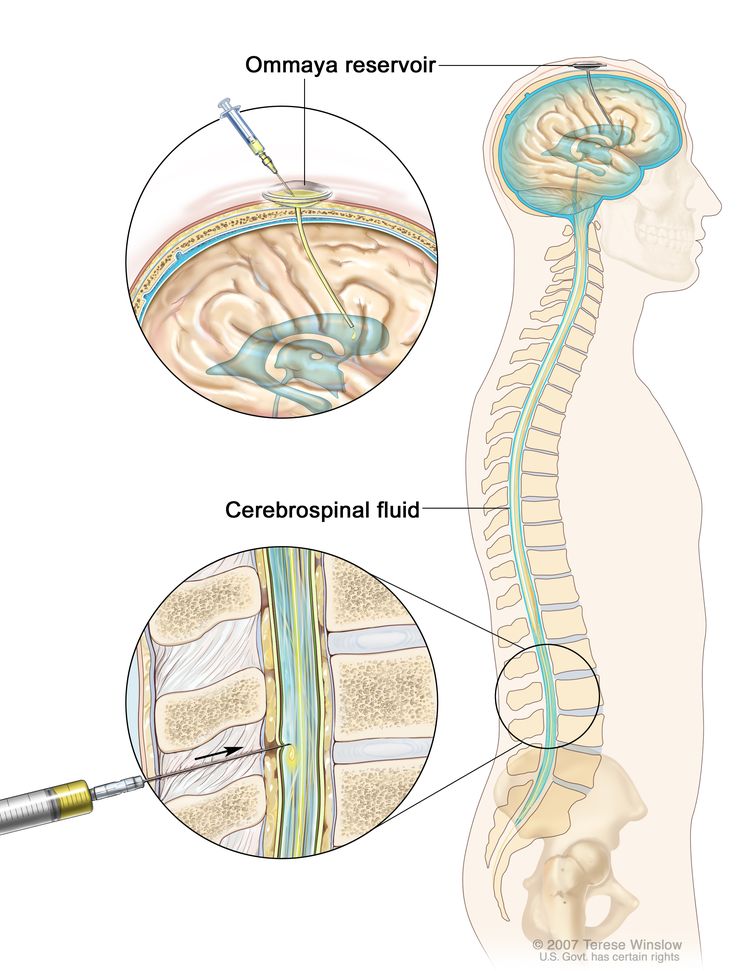
Intrathecal chemotherapy. Anticancer drugs are injected into the intrathecal space, which is the space that holds the cerebrospinal fluid (CSF, shown in blue). There are two different ways to do this. One way, shown in the top part of the figure, is to inject the drugs into an Ommaya reservoir (a dome-shaped container that is placed under the scalp during surgery; it holds the drugs as they flow through a small tube into the brain). The other way, shown in the bottom part of the figure, is to inject the drugs directly into the CSF in the lower part of the spinal column, after a small area on the lower back is numbed.
Chemotherapy drugs used alone or in combination to treat non-Hodgkin lymphoma in children include:
- asparaginase
- carboplatin
- cyclophosphamide
- cytarabine
- dexamethasone (steroid)
- doxorubicin
- etoposide
- idarubicin
- ifosfamide
- methotrexate
- prednisone (steroid)
- vinblastine
- vincristine
Other chemotherapy drugs not listed here may also be used.
The way the chemotherapy is given depends on the type and stage of the cancer being treated.
Learn more about Chemotherapy to Treat Cancer.
Radiation therapy
Radiation therapy uses high-energy x-rays or other types of radiation to kill cancer cells or keep them from growing. External radiation therapy uses a machine outside the body to send radiation toward the area of the body with cancer. External radiation therapy may be used to treat childhood non-Hodgkin lymphoma that has spread, or may spread, to the brain and spinal cord. It may also be used to treat cutaneous T-cell lymphoma (mycosis fungoides).
Learn more about External Beam Radiation Therapy for Cancer and Radiation Therapy Side Effects.
Stem cell transplant
High doses of chemotherapy are given to kill cancer cells. This treatment destroys healthy cells, including blood-forming cells. Stem cell transplant is a treatment to replace the blood-forming cells. Stem cells (immature blood cells) are removed from the blood or bone marrow of the patient or a donor and are frozen and stored. After the patient completes chemotherapy, the stored stem cells are thawed and given to the patient through an infusion. These reinfused stem cells grow into (and restore) the body's blood cells. The donor stem cells may also find and kill any cancer cells left in the body.
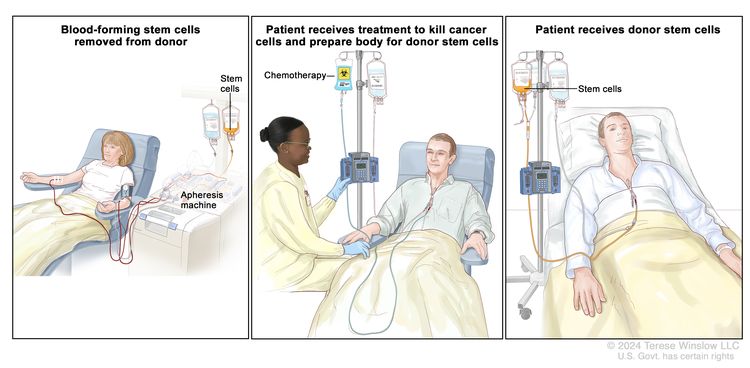
Donor stem cell transplant. (Step 1): Four to five days before donor stem cell collection, the donor receives a medicine to increase the number of stem cells circulating through their bloodstream (not shown). The blood-forming stem cells are then collected from the donor through a large vein in their arm. The blood flows through an apheresis machine that removes the stem cells. The rest of the blood is returned to the donor through a vein in their other arm. (Step 2): The patient receives chemotherapy to kill cancer cells and prepare their body for the donor stem cells. The patient may also receive radiation therapy (not shown). (Step 3): The patient receives an infusion of the donor stem cells.
Targeted therapy
Targeted therapy uses drugs or other substances to block the action of specific enzymes, proteins, or other molecules involved in the growth and spread of cancer cells. Types of targeted therapy used to treat non-Hodgkin lymphoma in children include:
Learn more about Targeted Therapy to Treat Cancer.
Other drug therapy
Retinoids are drugs related to vitamin A. Retinoid therapy with bexarotene is used to treat several types of cutaneous T-cell lymphoma.
Steroids are hormones made naturally in the body. They can also be made in a laboratory and used as drugs. Steroid therapy that is applied to the skin is used to treat cutaneous T-cell lymphoma. Dexamethasone and prednisone are steroids used with other drugs to treat certain types of lymphoma.
Antibiotics are drugs used to treat infections and cancer caused by bacteria or other microorganisms. Antibiotics have been used to treat mucosa-associated lymphoid tissue (MALT) lymphoma. Treatment with antibiotic therapy has been mostly studied in adults.
Phototherapy
Phototherapy uses a drug and a certain type of laser light to kill cancer cells. A drug that is not active until it is exposed to light is injected into a vein. The drug collects more in cancer cells than in normal cells. For cancer in the skin, laser light is shined onto the skin and the drug becomes active and kills the cancer cells. Phototherapy is used in the treatment of cutaneous T-cell lymphoma.
Watchful waiting
Watchful waiting is closely monitoring a patient's condition without giving any treatment until signs or symptoms appear or change.
Immunotherapy
Immunotherapy helps a person's immune system fight cancer. Types of immunotherapy include:
- CAR T-cell therapy changes the patient's T cells (a type of immune system cell) so they will attack certain proteins on the surface of cancer cells. T cells are taken from the patient and special receptors are added to their surface in the laboratory. The changed cells are called chimeric antigen receptor (CAR) T cells. The CAR T cells are grown in the laboratory and given to the patient by infusion. The CAR T cells multiply in the patient's blood and attack cancer cells. CAR T-cell therapy is being studied in the treatment of Burkitt lymphoma and diffuse large B-cell lymphoma that has not responded to treatment or has recurred (come back).
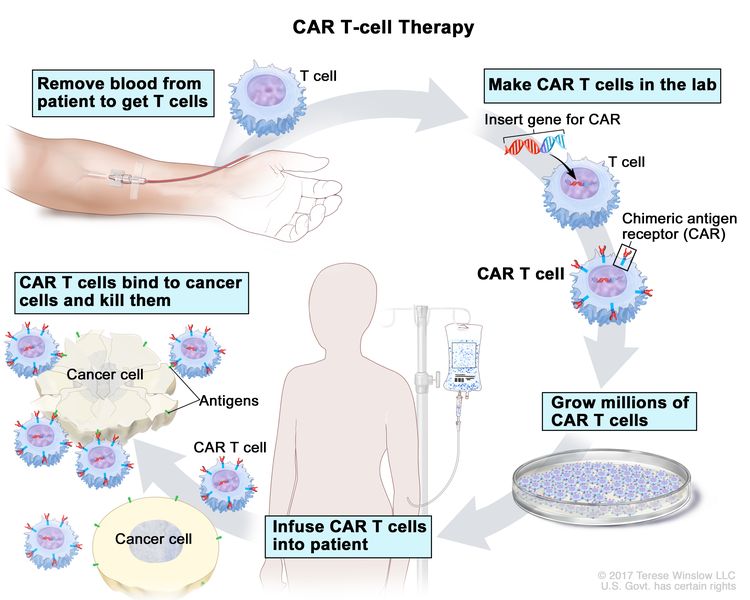
CAR T-cell therapy. A type of treatment in which a patient’s T cells (a type of immune cell) are changed in the laboratory so they will bind to cancer cells and kill them. Blood from a vein in the patient’s arm flows through a tube to an apheresis machine (not shown), which removes the white blood cells, including the T cells, and sends the rest of the blood back to the patient. Then, the gene for a special receptor called a chimeric antigen receptor (CAR) is inserted into the T cells in the laboratory. Millions of the CAR T cells are grown in the laboratory and then given to the patient by infusion. The CAR T cells are able to bind to an antigen on the cancer cells and kill them.
- Cyclosporine A is used in combination with steroids to treat subcutaneous panniculitic T-cell lymphoma.
Learn more about Immunotherapy to Treat Cancer.
Treatment for childhood non-Hodgkin lymphoma may cause side effects.
Cancer treatments can cause side effects. Which side effects your child might have depends on the type of treatment they receive, the dose, and how their body reacts. Talk with your child's treatment team about which side effects to look for and ways to manage them.
To learn more about side effects that begin during treatment for cancer, visit Side Effects.
Problems from cancer treatment that begin 6 months or later after treatment and continue for months or years are called late effects. Late effects of cancer treatment may include:
- physical problems, including problems with the heart, bones, and fertility
- changes in mood, feelings, thinking, learning, or memory
- second cancers (new types of cancer), such as brain tumors, acute myeloid leukemia, and myelodysplastic syndrome
Some late effects may be treated or controlled. It is important to talk with your child's doctors about the effects cancer treatment can have on your child. Learn more about Late Effects of Treatment for Childhood Cancer.
Patients may want to think about taking part in a clinical trial.
For some children, joining a clinical trial may be an option. There are different types of clinical trials for childhood cancer. For example, a treatment trial tests new treatments or new ways of using current treatments. Supportive care and palliative care trials look at ways to improve quality of life, especially for those who have side effects from cancer and its treatment.
You can use the clinical trial search to find NCI-supported cancer clinical trials accepting participants. The search allows you to filter trials based on the type of cancer, your child's age, and where the trials are being done. Clinical trials supported by other organizations can be found on the ClinicalTrials.gov website.
Learn more about clinical trials, including how to find and join one, at Clinical Trials Information for Patients and Caregivers.
Follow-up care may be needed.
As your child goes through treatment, they will have follow-up tests or check-ups. Some tests that were done to diagnose or stage the cancer may be repeated to see how well the treatment is working. Decisions about whether to continue, change, or stop treatment may be based on the results of these tests.
Some of the tests will continue to be done from time to time after treatment has ended. The results of these tests can show if your child's condition has changed or if the cancer has recurred (come back).
Treatment Options for Childhood Non-Hodgkin Lymphoma
In This Section
- Burkitt lymphoma
- Treatment of Burkitt lymphoma
- Treatment of recurrent or refractory Burkitt lymphoma
- Diffuse large B-cell lymphoma
- Treatment of diffuse large B-cell lymphoma
- Treatment of recurrent or refractory diffuse large B-cell lymphoma
- Primary Mediastinal B-cell Lymphoma
- Treatment of primary mediastinal B-cell lymphoma
- Treatment of recurrent or refractory primary mediastinal B-cell lymphoma
- Lymphoblastic Lymphoma
- Treatment of lymphoblastic lymphoma
- Treatment of recurrent or refractory lymphoblastic lymphoma
- Anaplastic Large Cell Lymphoma
- Treatment of anaplastic large cell lymphoma
- Treatment of recurrent or refractory anaplastic large cell lymphoma
- Lymphoproliferative Disease Associated With Immunodeficiency in Children
- Treatment of lymphoproliferative disease associated with primary immunodeficiency
- Treatment of non-Hodgkin lymphoma associated with DNA repair defect syndromes
- Treatment of HIV-associated non-Hodgkin lymphoma
- Treatment of post-transplant lymphoproliferative disease
- Rare NHL Occurring in Children
- Treatment of pediatric-type follicular lymphoma
- Treatment of marginal zone lymphoma
- Treatment of primary CNS lymphoma
- Treatment of peripheral T-cell lymphoma
- Treatment of cutaneous T-cell lymphoma
- Treatment of mycosis fungoides
- Treatment of lymphomatoid papulosis
Burkitt lymphoma
Treatment of Burkitt lymphoma
For information about the treatments listed below, see Treatment Option Overview.
Treatment of newly diagnosed Burkitt lymphoma may include:
- surgery to remove as much of the tumor as possible, followed by combination chemotherapy
- combination chemotherapy with or without targeted therapy (rituximab)
Treatment of recurrent or refractory Burkitt lymphoma
For information about the treatments listed below, see Treatment Option Overview.
Treatment of recurrent or refractory Burkitt lymphoma may include:
- combination chemotherapy with or without targeted therapy (rituximab)
- targeted therapy (rituximab), combination chemotherapy, and dexamethasone
- high-dose chemotherapy with stem cell transplant with the patient's own cells or cells from a donor
- CAR T-cell therapy
Use our clinical trial search to find NCI-supported cancer clinical trials that are accepting patients. You can search for trials based on the type of cancer, the age of the patient, and where the trials are being done. General information about clinical trials is also available.
Diffuse large B-cell lymphoma
Treatment of diffuse large B-cell lymphoma
For information about the treatments listed below, see Treatment Option Overview.
Treatment of newly diagnosed diffuse large B-cell lymphoma may include:
- surgery to remove as much of the tumor as possible, followed by combination chemotherapy
- combination chemotherapy with or without targeted therapy (rituximab)
Treatment of recurrent or refractory diffuse large B-cell lymphoma
For information about the treatments listed below, see Treatment Option Overview.
Treatment of recurrent or refractory diffuse large B-cell lymphoma may include:
- combination chemotherapy with or without targeted therapy (rituximab)
- targeted therapy (rituximab), combination chemotherapy, and dexamethasone
- stem cell transplant with the patient's own cells or cells from a donor
- CAR T-cell therapy
Use our clinical trial search to find NCI-supported cancer clinical trials that are accepting patients. You can search for trials based on the type of cancer, the age of the patient, and where the trials are being done. General information about clinical trials is also available.
Primary Mediastinal B-cell Lymphoma
Treatment of primary mediastinal B-cell lymphoma
For information about the treatments listed below, see Treatment Option Overview.
Treatment of newly diagnosed primary mediastinal B-cell lymphoma may include combination chemotherapy, prednisone, targeted therapy (rituximab), and sometimes radiation therapy.
Treatment of recurrent or refractory primary mediastinal B-cell lymphoma
For information about the treatments listed below, see Treatment Option Overview.
Treatment of recurrent or refractory primary mediastinal B-cell lymphoma may include targeted therapy (pembrolizumab).
Use our clinical trial search to find NCI-supported cancer clinical trials that are accepting patients. You can search for trials based on the type of cancer, the age of the patient, and where the trials are being done. General information about clinical trials is also available.
Lymphoblastic Lymphoma
Treatment of lymphoblastic lymphoma
For information about the treatments listed below, see Treatment Option Overview.
Lymphoblastic lymphoma may be classified as the same disease as acute lymphoblastic leukemia (ALL). Treatment of lymphoblastic lymphoma may include:
- combination chemotherapy
- CNS prophylaxis with radiation therapy or intrathecal chemotherapy may also be given to keep cancer from spreading to the brain or spinal cord
Treatment of recurrent or refractory lymphoblastic lymphoma
For information about the treatments listed below, see Treatment Option Overview.
Treatment of recurrent or refractory lymphoblastic lymphoma may include:
- chemotherapy
- stem cell transplant with cells from a donor
Use our clinical trial search to find NCI-supported cancer clinical trials that are accepting patients. You can search for trials based on the type of cancer, the age of the patient, and where the trials are being done. General information about clinical trials is also available.
Anaplastic Large Cell Lymphoma
Treatment of anaplastic large cell lymphoma
For information about the treatments listed below, see Treatment Option Overview.
Treatment of anaplastic large cell lymphoma may include:
- surgery followed by combination chemotherapy
- combination chemotherapy with or without prednisone
- intrathecal and combination chemotherapy, for patients with cancer in the brain or spinal cord
Treatment of recurrent or refractory anaplastic large cell lymphoma
For information about the treatments listed below, see Treatment Option Overview.
Treatment of recurrent or refractory anaplastic large cell lymphoma may include:
- chemotherapy
- targeted therapy (brentuximab vedotin or crizotinib)
- chemotherapy followed by a stem cell transplant with the patient's own cells or cells from a donor
Use our clinical trial search to find NCI-supported cancer clinical trials that are accepting patients. You can search for trials based on the type of cancer, the age of the patient, and where the trials are being done. General information about clinical trials is also available.
Lymphoproliferative Disease Associated With Immunodeficiency in Children
Treatment of lymphoproliferative disease associated with primary immunodeficiency
For information about the treatments listed below, see Treatment Option Overview.
Treatment of lymphoproliferative disease in children and adolescents with weakened immune systems may include:
- chemotherapy with or without targeted therapy (rituximab)
- stem cell transplant with cells from a donor may be used to treat the primary immunodeficiency and to decrease the risk of cancer coming back
Treatment of non-Hodgkin lymphoma associated with DNA repair defect syndromes
For information about the treatments listed below, see Treatment Option Overview.
Treatment of non-Hodgkin lymphoma associated with DNA repair defect syndromes in children may include chemotherapy.
Treatment of HIV-associated non-Hodgkin lymphoma
For information about the treatments listed below, see Treatment Option Overview.
Treatment with highly active antiretroviral therapy or HAART (a combination of antiretroviral drugs) lowers the risk of non-Hodgkin lymphoma in patients infected with HIV.
Treatment of HIV-related non-Hodgkin lymphoma (NHL) in children may include chemotherapy with or without targeted therapy (rituximab).
Treatment of post-transplant lymphoproliferative disease
For information about the treatments listed below, see Treatment Option Overview.
Treatment of post-transplant lymphoproliferative disease may include:
- Surgery to remove the tumor. If possible, lower doses of immunosuppressive drugs after a stem cell or organ transplant may be given.
- Targeted therapy (rituximab).
- Chemotherapy with or without targeted therapy (rituximab).
Rare NHL Occurring in Children
Treatment of pediatric-type follicular lymphoma
For information about the treatments listed below, see Treatment Option Overview.
Treatment of follicular lymphoma in children may include:
- surgery
- combination chemotherapy with or without targeted therapy (rituximab)
For children whose cancer has certain changes in the genes, treatment is similar to that given to adults with follicular lymphoma. For information about the treatment of follicular lymphoma in adults, visit Non-Hodgkin Lymphoma.
Treatment of marginal zone lymphoma
For information about the treatments listed below, see Treatment Option Overview.
Treatment of marginal zone lymphoma (including mucosa-associated lymphoid tissue [MALT] lymphoma) in children may include:
- surgery
- radiation therapy
- targeted therapy (rituximab) with or without chemotherapy
- antibiotic therapy, for MALT lymphoma
Treatment of primary CNS lymphoma
For information about the treatments listed below, see Treatment Option Overview.
Treatment of primary CNS lymphoma in children may include chemotherapy and targeted therapy (rituximab).
Treatment of peripheral T-cell lymphoma
For information about the treatments listed below, see Treatment Option Overview.
Treatment of peripheral T-cell lymphoma in children may include:
- chemotherapy
- radiation therapy
- stem cell transplant with the patient's own cells or cells from a donor
Treatment of cutaneous T-cell lymphoma
For information about the treatments listed below, see Treatment Option Overview.
Treatment of subcutaneous panniculitis-like T-cell lymphoma in children may include:
- watchful waiting
- immunotherapy using steroids with or without cyclosporine A or ruxolitinib
- targeted therapy (denileukin diftitox)
- combination chemotherapy
- retinoid therapy
- stem cell transplant
Treatment of cutaneous anaplastic large cell lymphoma may include surgery, radiation therapy, or both.
Treatment of mycosis fungoides
For information about the treatments listed below, see Treatment Option Overview.
In children, treatment of mycosis fungoides may include:
- steroids applied to the skin
- retinoid therapy
- radiation therapy
- phototherapy (light therapy using ultraviolet B radiation)
Treatment of lymphomatoid papulosis
For information about the treatments listed below, see Treatment Option Overview.
In children, treatment of lymphomatoid papulosis may include:
- watchful waiting
- steroids applied to the skin
- phototherapy (light therapy using ultraviolet B radiation)
- low doses of chemotherapy (methotrexate)
To Learn More About Childhood Non-Hodgkin Lymphoma
For more information from the National Cancer Institute about childhood non-Hodgkin lymphoma, visit:
For more childhood cancer information and other general cancer resources, visit:
- About Cancer
- Childhood Cancers
- CureSearch for Children's Cancer
- Late Effects of Treatment for Childhood Cancer
- Adolescents and Young Adults with Cancer
- Children with Cancer: A Guide for Parents
- Cancer in Children and Adolescents
- Cancer Staging
- Coping with Cancer
- Questions to Ask Your Doctor about Cancer
- For Survivors, Caregivers, and Advocates
About This PDQ Summary
About PDQ
Physician Data Query (PDQ) is the National Cancer Institute's (NCI's) comprehensive cancer information database. The PDQ database contains summaries of the latest published information on cancer prevention, detection, genetics, treatment, supportive care, and complementary and alternative medicine. Most summaries come in two versions. The health professional versions have detailed information written in technical language. The patient versions are written in easy-to-understand, nontechnical language. Both versions have cancer information that is accurate and up to date and most versions are also available in Spanish.
PDQ is a service of the NCI. The NCI is part of the National Institutes of Health (NIH). NIH is the federal government’s center of biomedical research. The PDQ summaries are based on an independent review of the medical literature. They are not policy statements of the NCI or the NIH.
Purpose of This Summary
This PDQ cancer information summary has current information about the treatment of childhood non-Hodgkin lymphoma. It is meant to inform and help patients, families, and caregivers. It does not give formal guidelines or recommendations for making decisions about health care.
Reviewers and Updates
Editorial Boards write the PDQ cancer information summaries and keep them up to date. These Boards are made up of experts in cancer treatment and other specialties related to cancer. The summaries are reviewed regularly and changes are made when there is new information. The date on each summary ("Updated") is the date of the most recent change.
The information in this patient summary was taken from the health professional version, which is reviewed regularly and updated as needed, by the PDQ Pediatric Treatment Editorial Board.
Clinical Trial Information
A clinical trial is a study to answer a scientific question, such as whether one treatment is better than another. Trials are based on past studies and what has been learned in the laboratory. Each trial answers certain scientific questions in order to find new and better ways to help cancer patients. During treatment clinical trials, information is collected about the effects of a new treatment and how well it works. If a clinical trial shows that a new treatment is better than one currently being used, the new treatment may become "standard." Patients may want to think about taking part in a clinical trial. Some clinical trials are open only to patients who have not started treatment.
Clinical trials can be found online at NCI's website. For more information, call the Cancer Information Service (CIS), NCI's contact center, at 1-800-4-CANCER (1-800-422-6237).
Permission to Use This Summary
PDQ is a registered trademark. The content of PDQ documents can be used freely as text. It cannot be identified as an NCI PDQ cancer information summary unless the whole summary is shown and it is updated regularly. However, a user would be allowed to write a sentence such as “NCI’s PDQ cancer information summary about breast cancer prevention states the risks in the following way: [include excerpt from the summary].”
The best way to cite this PDQ summary is:
PDQ® Pediatric Treatment Editorial Board. PDQ Childhood Non-Hodgkin Lymphoma Treatment. Bethesda, MD: National Cancer Institute. Updated <MM/DD/YYYY>. Available at: https://www.cancer.gov/types/lymphoma/patient/child-nhl-treatment-pdq. Accessed <MM/DD/YYYY>. [PMID: 26389294]
Images in this summary are used with permission of the author(s), artist, and/or publisher for use in the PDQ summaries only. If you want to use an image from a PDQ summary and you are not using the whole summary, you must get permission from the owner. It cannot be given by the National Cancer Institute. Information about using the images in this summary, along with many other images related to cancer can be found in Visuals Online. Visuals Online is a collection of more than 3,000 scientific images.
Disclaimer
The information in these summaries should not be used to make decisions about insurance reimbursement. More information on insurance coverage is available on Cancer.gov on the Managing Cancer Care page.
Contact Us
More information about contacting us or receiving help with the Cancer.gov website can be found on our Contact Us for Help page. Questions can also be submitted to Cancer.gov through the website’s E-mail Us.
Updated:
Source URL: https://www.cancer.gov/node/4799/syndication
Source Agency: National Cancer Institute (NCI)
Captured Date: 2013-09-14 09:02:27.0








